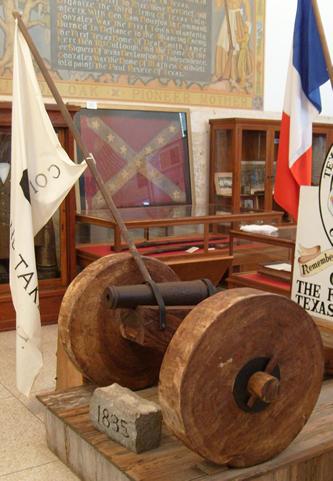|
|
The
Texas women of 1836 unknowingly wrote their own history. Their strength
surpassed more than most could ever imagine. This time of the year,
the spring, I always think about them.
“The men of Texas deserved much credit, but more was due the women.
Armed men facing a foe could not but be brave; but the women, with
their little children around them, without means of defense or power
to resist, faced danger and death with unflinching courage.”
Thomas Rusk
“The younger and stouter women would take the feeble ones on their
backs and shoulders and wade through the water to dry land, set them
down and then go back for another load, and continued until all were
over. There is no one who can do justice to the women at that time.
God bless the women of Texas!”
S. F. Sparks
The
women who came to Texas were strong beyond means. They faced every
hardship and danger that one can imagine and still they survived.
The following stories relate the tales of a few of these women. The
first is an unnamed woman from Anahuac.
The second story will be the tragic story of Susannah
Dickinson, who along with her baby Angelina, survived the
fall of the Alamo. The third is Mary Millsap, the wife of Isaac
Millsap who died March 6, 1836 at the Alamo.
My daughter-in-law is of the Millsap family.
The
families who arrived in Texas as part of Austin’s “Original Three
Hundred” found various ways to deal with the hardships of this new
land. They even received assistance from the Mexican Comandante
at Bexar. Indian attacks kept the people of Gonzales
on their toes. The Mexican government presented the people of Gonzales
with a cannon.
The gun was almost worthless but the loud noise that it made helped
the settlers in defense of the Indians.
Most of the Mexican forces found in Texas
at this time were presidarios, the worst convicts of Mexico.
The Mexican government drafted these convicts into the armies. This
posed a problem and may have contributed to the start of the war.
The settlers and the presidarios were constantly at odds with
each other. The incident at the town of Anahuac
is just one example of retaliation against the Mexicans, a retaliation
that could have sparked the flame that would later become the full
blown fire of independence.
The Mexican forces, of mostly the dreaded presidarios, controlled
the garrison at Anahuac.
One morning, four presidarios entered the home of one of the
settlers. A home occupied by a lone woman. These soldiers found themselves
facing this woman and decided to take advantage of the situation.
Little did they know what they were about to encounter. This little
woman fought and screamed like a wild cat. Some men, working nearby,
heard her screams and rushed to her aid. Finding the door locked from
the inside, the men took a post and battered down the door. Three
of the presidarios escaped and the fourth almost found himself
hanging from the nearest tree. The settlers decided that hanging would
be too big of an insult to the flag of Mexico, since the captured
man was a soldier but a message must be sent to the presidarios
The presidario was in a heck of a mess and things were about
to get worse. The settlers took tar and coated the man’s entire body.
The woman, that he had helped abuse, took the feathers from her bed
and covered him with them. The settlers took the tarred and feathered
presidario on a little walk through the main street of town
and directly to the Mexican garrison with the warning that if anything
like this offense happened again that there would not be a presidario
left alive.
The Mexican Presidarios were not happy with this little incident and
their reaction resulted in the arrest of several soon to be heroes,
namely one William Travis. One thing led to another. The settlers
met and words of revolution began to spread. The Mexicans released
the Anglos but the settlers were still not happy and the smoke of
revolution began to cloak the horizon.
A few years after the incident at Anahuac,
Capitan Castenado headed to Gonzales
to retrieve the
old iron cannon that Mexican government had previously given to
the settlers. His orders were to use force if necessary but no matter
what to get the cannon.
Captain Albert Martin sent messengers to the settlers in the surrounding
areas to come to his aid. The fire just got hotter. |
 |
At this point,
the men of Gonzales
knew that the feared Mexican forces would be on the move. With this
thought in mind, the people of Gonzales
began doing what they could to support the upcoming revolution. Settlers
donated all their iron. The women brought in their flat irons, pots
and pans. One woman even gave the spindle from her spinning wheel.
In the midst of preparing to march to San
Antonio, the people of Gonzales
decided that they needed a flag. An appointed committee designed what
they considered a flag of support for the cause. Again the women rallied.
The committee took material in the form of the ladies cherished silk
dresses. These dresses were in all shades and textures. One woman
donated her only set of green window curtains. |
|
|
